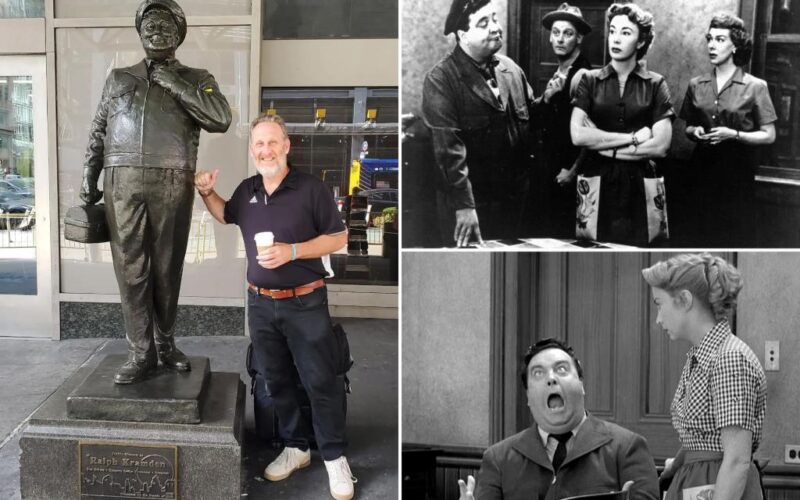The honeymoon ain’t over.
It’s been 70 years since the debut of “The Honeymooners” but fans of the iconic sitcom say it’s still ingrained in pop culture – and in the fabric of the Big Apple.
Catchphrases like “to the moon, Alice,” “baby, you’re the greatest” and “hey Ralphie boy” are immediately recognizable as the Brooklyn-based black-and-white comedy keeps people watching over and over again decades after its Oct. 1, 1955, premiere.
The reason why the episodes are so durable was best explained by the show’s late star and mastermind Jackie Gleason, his stepson said in a recent interview.
“Well, Jackie answered that quite simply: Because they’re funny,” said Craig Horwich, the son of Gleason’s widow Marilyn Taylor. “And that really is the perennial answer.”
“The Honeymooners” lasted only one season – but the exploits of bus driver Ralph Kramden (Gleason), his always frustrated but ever-forgiving wife Alice (Audrey Meadows) and their neighbors the Nortons lived on for years in prime time syndication and even now is rerun in annual New Year’s Eve marathons on local TV.
Much of the success of the show hinged on the comedic skills of Gleason and co-star Art Carney, who played Ralph’s goofy sewer-worker best buddy Ed Norton – TV’s first and arguably best wacky neighbor, experts said. Rounding out the main cast was Ed’s wife, Trixie (Joyce Randolph).
“They knew how to react to other performers. They knew how to listen,” said Horwich, who now co-runs Jackie Gleason Enterprises with Gleason’s two daughters. They were very present and familiar and comfortable in front of an audience. And I think you could put Art Carney and most anyone on a stage and they would be able to hold your attention.”
The actors had already been mastering the characters for years, with “The Honeymooners” beginning as a sketch in October 1951 on the variety show “Cavalcade of Stars” with a different Alice (Pert Kelton) and Trixie (Elaine Stritch).
It continued when Gleason jumped to the hour-long “Jackie Gleason Show,” where the core four of the series was in place and the show’s essence was firmly set – with a premise so simple and repeatable it’s been said they could be watched in any order.
Author and scholar David Sterritt, who wrote a book on “The Honeymooners” as part of a series called TV Milestones, said the “Classic 39” have a familiar structure like a good rock song or sonnet. Its catchphrases and “riffs” recur like a good chorus, he noted.
“A show like ‘The Honeymooners,’ which is so musical in its use of language, which is musical in its rhythms, has some of the appeal of music – and therefore it can be taken in over and over again,” Sterritt, who grew up watching the show on Long Island in the 1950s, told The Post.
Although the show is remembered for its laughs, there’s deep pathos in the premise and characters. Ralph and his buddy Ed always have grand plans but their get-rich-quick schemes always end up falling apart. Ralph’s alpha personality usually puts him at odds with his wife or his best friend, before invariably they end up with an apology and back at Square 1.
It mostly takes place in a small sparsely decorated one-room bedroom in Bensonhurst, based on the home Gleason grew up in where he’d later say he knew many “Kramdens” and “Nortons,” according to his stepson. A lot of the show’s staying power is that the characters were relatable – they argued loudly, they struggled with cash decisions and worked blue-collar jobs.
“It’s a dark undercurrent for the show, but it’s an undercurrent and the thing is still a comedy, so we can enjoy it,” Sterritt said. “We can enjoy the darkness of it because we know that it’s not threatening darkness.”
Gleason died in 1987, but he’s immortalized in character as Kramden in a statue at the Port Authority Bus Terminal in Manhattan. It even attracts fans and passersby today, like Rick Witkowsky, who stopped for a pic with the statue during a visit from Virginia with his wife, Deb.
“When we left the hotel to go to Central Park this morning my wife saw the statue and I was like, ‘Oh man! We got to catch that on the way back cause I just love Ralph,” Witkowsky, 72, said, calling the show “so New York.”
Plumber CJ Matos, 32, said he uses the statue as a daily meetup spot to wait for his friends to ride the train home to New Jersey.
I always tell my friends when they’re coming to meet me, I’m standing here next to my buddy Ralph. Ralphie boy,” he said. “I figure it’s fitting, we’re plumbers. Norton was a plumber, right. I mean, he worked in the sewers.”
Bryan Farrell, 52, an exterminator from Levittown, called it a “fantastic timeless show” as he rattled through several plots of the episodes.
“There never was another show that was that funny. Universally funny,” he said.








